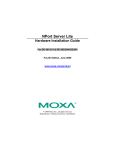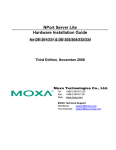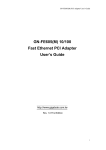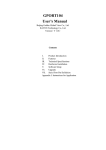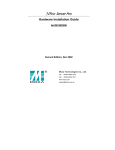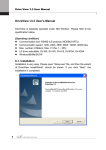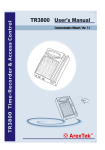Download Moxa Technologies DE-304 Installation guide
Transcript
NPort Server Lite Hardware Installation Guide for DE-301/331 & DE-302/304/332/334 Second Edition, Dec 2002 Moxa Technologies Co., Ltd. Tel: +866-2-8919-1230 Fax: +886-2-8919-1231 www.moxa.com [email protected] NPort Server Lite Hardware Installation Guide for DE-301/331&DE-302/304/332/334 The software described in this manual is furnished under a license agreement and may be used only in accordance with the terms of that agreement. Copyright Notice Copyright 2002 Moxa Technologies Co., Ltd. All rights reserved. Reproduction without permission is prohibited. Trademarks MOXA is a registered trademark of Moxa Technologies Co., Ltd. All other trademarks or registered marks in this manual belong to their respective manufacturers. Disclaimer Information in this document is subject to change without notice and does not represent a commitment on the part of Moxa. Moxa provides this document “as is,” without warranty of any kind, either expressed or implied, including, but not limited to, the particular purpose. Moxa reserves the right to make improvements and/or changes to this manual or the product(s) and/or program(s) described herein at any time. Information provided in this manual is intended to be accurate and reliable. However, Moxa Technologies assumes no responsibility for its use, or for any infringements on the rights of fourth parties which may result from its use. This product could include technical or typographical errors. Changes are periodically made to the information herein, and these changes may be incorporated in new editions of the publication. MOXA Internet Services Services Customer satisfaction is our number one concern. To ensure that customers receive the full benefit of our products, Moxa Internet Services has been set up to provide technical support, driver updates, product information, and user’s manual updates. The following services are provided: E-mail for technical support: address: [email protected] Latest drivers and documents: address: or http://www.moxa.com http://www.moxa.com.tw World Wide Web (WWW) site for product information: address: or http://www.moxa.com http://www.moxa.com.tw Table of Contents 1. Introduction....................................................................... 1-1 Features...................................................................................... 1-2 Product Specifications ................................................................ 1-2 Package Checklist ...................................................................... 1-3 Front/Top/Rear/Bottom/Right Panel Views ................................. 1-4 2. Connecting the Hardware ................................................ 2-1 Choosing a Location................................................................... 2-1 Desktop ................................................................................. 2-1 Wall or Cabinet...................................................................... 2-2 DIN Rail ................................................................................. 2-3 Network Connection ................................................................... 2-5 Power Connection ...................................................................... 2-6 Serial Connection ....................................................................... 2-6 3. Using the Built-In LCD Panel to Configure NPort Server Lite .............................................................. 3-1 4. Troubleshooting ............................................................... 4-1 Installation and Configuration Troubleshooting .......................... 4-1 Programming Problems.............................................................. 4-5 A. Cable Pinouts .................................................................. A-1 B. Declaration of Conformity .............................................. B-1 1 1 Introduction Welcome to Moxa NPort Server Lite, an Industrial Serial Device Server that greatly enhances the ability of a Windows 95/98/Me/NT/2000/XP host to control multiple serial devices over a TCP/IP based Ethernet network. This chapter is an introduction to NPort Server Lite and includes the following: ❑ ❑ ❑ ❑ Features Product Specifications Package Checklist Front/Top/Rear/Bottom/Right Panel Views NPort Server Lite provides a data communications solution for connecting Windows hosts to multiple asynchronous RS-232 (models DE-301/302/304) or RS-422/485 (models DE-331/332/334) serial ports through a TCP/IP network. Each model has one (DE-301/331), two (DE-302/332), or four (DE-304/334) asynchronous serial port connections on one side, and one 10/100 Mbps Ethernet connection on the other, allowing any device that supports the asynchronous communications protocol to attach to a network. NPort Server Lite works like an add-on multiport serial board to the Windows host, but with one major advantage—the TCP/IP network. Since the Windows host communicates with the COM ports on NPort Server Lite over a TCP/IP network, you are able to control asynchronous serial devices from virtually anywhere in the world. Although it connects through the virtual link of the Ethernet, the ports on NPort Server Lite are recognized as Real COM ports by the Windows operating system. NPort Server Lite provides both the basic transmit/receive data functions, as well as RTS, CTS, DTR, DSR, and DCD control signals. NPort Server Lite can be used with your existing applications that support serial communication. It also comes with a utility program providing a simple step-by-step installation procedure, and a maintenance wizard that gives you easy access to your asynchronous devices. 1-1 Features ❑ ❑ ❑ ❑ ❑ ❑ ❑ ❑ ❑ Auto-detecting 10/100 Mbps Ethernet 1/2/4 port RS-232/422/485 serial interface LCD IP address display and configuration Built-in Ethernet and TCP/IP protocol Supports Driver, TCP Server, TCP Client, UDP Server/Client, and Pair Connection (only for DE-301/331) operation modes Ports on multiport units can be individually configured with different operation modes Supports Windows Real COM drivers and Linux real tty drivers Automatic network connection recovery Suitable for both desktop and DIN-Rail installation Product Specifications Hardware Processor I/O controller: DE-301/331 DE-302/332 DE-304/334 Memory Connector type Interface LAN Serial No. of ports Signals: RS-232 RS-422 RS-485 Performance Speed Max. No. of ports 1-2 16 bit CPU 16C550C or compatible × 1 16C550C or compatible × 2 16C550C or compatible × 4 512 KB Male DB9 Auto-detecting 100Base-TX (10/100 Mbps) RS-232 or RS-422/485 1/2/4 TxD, RxD, RTS, CTS, DTR, DSR, DCD, GND TxD+/-, RxD+/-, RTS+/-, CTS+/-, GND Data+/-, GND 50 bps – 230.4 Kbps 256 (per Windows NT/2000/XP host) 128 (per Windows 95/98 host) Configuration Parity Data bits Stop bits None, even, odd, space, mark 5, 6, 7, 8 1, 1.5, 2 OS Support Windows XP, Windows 2000, Windows NT, Windows 95/98/Me, UnixWare SVR4.2, UnixWare7 SVR5, SCO Open Server, SCO UNIX, Linux real tty for 2.0.36 and above, 2.2.x, 2.4.x (Intel x86 running TCP/IP) Power and Environment Power Requirements 9 – 30 VDC, 1.05A/9V Operating Temp. 0 – 55℃ Operating Humidity 5 – 95% RH Storage Temp. -20 – 85℃ Dimensions 155 × 105 × 33 mm (W × D × H) Surge Protection 15 KV ESD for serial ports Magnetic Isolation 1.5 KV for Ethernet Regulatory Approvals FCC, CE, UL, CUL, TÜV Note: If you need a product with optical isolation, MOXA Transio A53, a smart RS-232 to RS-422/485 bi-directional converter, can be used with NPort Server Lite to provide up to 2 KV of optical isolation. Package Checklist ❑ ❑ ❑ ❑ ❑ ❑ ❑ ❑ ❑ One NPort Server Lite NPort Server Lite Hardware Installation Guide NPort Family Software Installation Guide Cross-over 10/100 Mbps Ethernet cable Power Adaptor (110V or 230V) Windows 95/98/Me/NT/2000/XP drivers (on CD) Optional Accessories A52: Smart RS-232 to RS-422/485 Bi-Directional Converter A53: Smart RS-232 to RS-422/485 Bi-Directional Converter; supports optical isolation protection (2 KV) Metal attachment plates and screws 1-3 Front/Top/Rear/Bottom/Right Panel Views 1. Male DB9 serial ports Note: Models DE-301/331 have only one port, and models DE-302/332 have only two ports. 2. PWR LED 3. LINK LED 4. TRAFFIC LED 5. LCD display panel Note: Before retrieving an IP address from the DHCP/BOOTP server, NPort will display “DHCP/BOOTP fail” every 1 second. 6. Input buttons for LCD display panel configuration 7. Reset button—press continuously for a. 3 sec to erase password After 3 sec, release the reset button at this time to erase password. 8. 100BaseTx Ethernet port 9. Power input 10. Rubber base pads 11. Attachment plate screw holes 12. Heat dissipation orifices 1-4 2 2 Connecting the Hardware Now that you have been introduced to NPort Server Lite's features and specifications, it’s time to set up the hardware. We cover the following topics in this chapter: ❑ ❑ ❑ ❑ Choosing a Location • Desktop • Wall or Cabinet • DIN Rail Network Connection Power Connection Serial Connection Choosing a Location There are three placement options available. NPort Server Lite can be: • • • placed on a desktop, fixed to a wall or inside a cabinet, or fixed to a 35-mm DIN Rail. Desktop One option is to place NPort Server Lite on a clean, flat, well-ventilated desktop. There are four rubber pads attached to the bottom of the server, and we recommend leaving sufficient room between NPort Server Lite and neighboring equipment to create enough clearance for air to circulate. You should also remember not to put anything on top of NPort Server Lite, since this could damage the internal components and obscure the server’s LCD panel. 2-1 Wall or Cabinet The two metal brackets included with NPort Server Lite can be used to attach the server to a wall, or the inside of a cabinet. Using three screws per bracket, first attach the brackets to the bottom of the server (Fig. 2-1a). Next, use two screws per bracket to attach the server to a wall or cabinet (Fig. 2-1b). Figure 2-1a. NPort Server Lite—Wall Mounting Brackets (bottom view) Figure 2-1b. NPort Server Lite—Wall Mounting Brackets (top view) 2-2 DIN Rail NPort Server Lite can also be mounted on a standard 35-mm DIN Rail. First, use two screws to attach each of the two DIN Rail brackets to the metal attachment plates (Figs. 2-2a, b). Figure 2-2a. DIN Rail Mounting Brackets—Inner Placement Figure 2-2b. DIN Rail Mounting Brackets—Outer Placement Since the screw heads are beveled, and the holes in the plate are countersunk, the tops of the screws will be flush with the metal plates. This allows the metal plates (now with the DIN Rail brackets attached) to be screwed to the bottom of the server. Use three screws to attach the metal plate to the bottom of NPort Server Lite, with the orientation as shown in Fig. 2-3a or Fig. 2-3b. 2-3 Figure 2-3a. Din Rail Mounting Brackets—Inner Placement Figure 2-3b. Din Rail Mounting Brackets—Outer Placement 2-4 The next step is to attach NPort Server Lite to the Din Rail. STEP 1: Insert the top of the DIN Rail into slot A of the DIN Rail mount. STEP 2: Push the bottom of NPort Server Lite so that the bottom of the DIN Rail snaps into slot B of the DIN Rail mount. To remove NPort Server Lite from the DIN Rail, simply reverse Steps 2 and 3 above by grasping the bottom of the NPort Express device server with both hands, and then using your fingers to pull down slightly on the DIN Rail mounts at slot B. This releases the bottom of the DIN Rail from the DIN Rail mount. Network Connection There are two ways to use the 10/100BaseT Ethernet jack located on NPort Server Lite’s rear panel. 1. For many of the applications using NPort Server Lite, you will simply plug one end of your Ethernet cable into the 10/100BaseT jack, and the other end into the hub connected to your network. In this case, use a standard straight-through Ethernet cable. 2. In some cases, such as when configuring drivers and software, you will find it convenient to hook NPort Server Lite directly to your computer’s Ethernet card. To do this you will need to use a cross-over Ethernet cable, such as the one supplied with your server. 2-5 Power Connection Take the following steps to connect NPort Server Lite’s power adaptor. 1. Connect the power adaptor’s DC plug into NPort Server Lite’s “DC-IN” jack. 2. Connect the power adaptor to an electrical outlet. Note that there is no on/off switch. The device server automatically turns on when plugged into the outlet. If the device server is working properly, the LCD panel back light will glow for a few seconds before shutting off, and the green PWR LED will also light up, indicating that the device server is receiving power. The LCD panel should look similar to the figure shown in Chapter 1. Serial Connection The model of NPort Server Lite that you purchased has either one (models DE-301/331), two (models DE-302/332), or four (models DE-304/334) male DB9 serial ports on the front panel. Depending on your serial device and serial interfaces, there are two connection options: 1. For an RS-232 port, you may use a DB9 to DB9 cable to connect your serial device to NPort Server Lite. Simply plug one end of the cable into one of the ports on the front panel of the server, and plug the other end into your serial device’s serial port. 2. Refer to Appendix A for details of NPort Server Lite’s DB9 pinouts, and then make your own cable. 2-6 3 3 Using the Built-In LCD Panel to Configure NPort Server Lite In this chapter, we explain how to use the four buttons on NPort Server Lite’s top panel to operate the LCD display. Basic Operation If the server is working properly, the LCD panel will display a yellow color for a few seconds, after which it turns green. The green PWR LED will also light up, indicating that the server is receiving power. You will see a display similar to: N 1 P 9 6 2 1 . 4 1 0 6 5 8 . S 1 N 2 : 7 6 . 1 2 4 5 0 4 5 This is where • • • NP61405 61405 192.168.127.254 is the server’s name is the server’s serial number is the server’s IP address There are four buttons on NPort Server Lite’s top panel of. Going from left to right, the buttons are: Button Name menu MENU SEL Action activates the main menu, or returns to a lower level scrolls up through a list of items shown on the LCD up cursor panel’s second line scrolls down through a list of items shown on the LCD down cursor panel’s second line selects the option listed on the LCD panel’s second line select 3-1 The buttons are manipulated in a manner similar to the way a modern cellular phone operates. As you move through the various functions and setting options, note that the top line shows the current menu or submenu name, and the bottom line shows the submenu name or menu item which is activated by pressing the SEL button. Detailed Menu Options The best way to explain all of NPort Server Lite’s LCD functions is to refer to the tree graph shown in Fig. 3-1. There are three main levels—1, 2, and 3—with each level represented by a separate column. The first thing to remember is that the MENU button is used to move back and forth between the LCD panel’s default screen, and main menu screen: N 1 P 9 6 2 1 . 4 1 0 6 5 8 M S A E I R N V M R E E . S 1 N 2 : 7 6 . 1 2 4 5 N S U E T T I N G 0 4 5 H ↓ In addition, you only need to remember to: • Use the SEL button to move up one level (i.e., left to right on the tree graph) • Use the MENU button to move down one level (i.e., right to left on the tree graph) • Use the cursor keys, and , to scroll between the various options within a level (i.e., up and down on the tree graph). As you use the buttons to operate the LCD display, you will notice that with very few exceptions, moving up one level causes the bottom line of the display to move to the top line of the display. You will also notice that the bottom three options in level 2, and all of the options in level 3 have either a C or D attached. The meaning is as follows: • C = configurable I.e., you are allowed to change the setting of this option • 3-2 D = display only I.e., the setting for this option is displayed, but it cannot be changed (this does NOT necessarily mean that the number doesn’t change; only that you can’t change it) Figure 3-1: Tree Graph Displaying LCD Menu Options 3-3 The part of the LCD operation that still requires some explanation is how to edit the configurable options. In fact, you will only encounter two types of configurable options. The first type involves entering numbers, such as IP addresses, Netmasks, etc. In this case, you change the number one digit at a time. The up cursor () is used to decrease the highlighted digit, the down cursor () is used to increase the highlighted digit, and the SEL button is used to move to the next digit. When the last digit has been changed, pressing SEL simply enters the number into NPort Server Lite’s memory. The second type of configurable option is when there are only a small number of options from which to choose (although only one option will be visible at a time). Consider the PARITY attribute under PORT SETTING as an example. Follow the tree graph to arrive at the following PARITY screen. The first option, NONE, is displayed, with a down arrow all the way to the right. This is an indication that there are other options from which to choose. P A R I N O N E T Y ↓ Press the down cursor button once to see EVEN as the second option. P A R I E V E N T Y ↑ ↓ Press the down cursor button again to see ODD as the third option. P A R O D D I T Y ↑ ↓ Press the down cursor button again to see Mark as the fourth option. P A R I M a r k T Y ↑ ↓ Press the down cursor button yet again to see the last option, Space. P A R I T S p a c e Y ↑ To choose the desired option, press the select button when the option is showing on the screen. 3-4 4 4 Troubleshooting This chapter explains how to solve some problems you could encounter while using NPort Server Lite. If you still have problems after reading this chapter, contact your dealer, or e-mail Moxa for help. You may also use the "Problem Report Form" at the end of this manual to notify your dealer that you require prompt technical support. We cover the following topics. ❑ ❑ Installation and Configuration Troubleshooting Programming Problems Installation and Configuration Troubleshooting A particular host PC is used to install an NPort Server Lite device server in Single Host mode, but after working successfully for an extended period of time, the same host PC is unable to access the NPort Server Lite device server. When a host PC is used to install an NPort Server Lite device server in Single Host mode, two things happen: (1) NPort Server Lite’s Single Host Mode driver is installed on the host PC, and (2) the host PC’s IP address is automatically entered into NPort Sever Lite’s access control table. For security reasons, and to simplify operation, Single-Host Mode allows only one host IP to be entered into its access control table. Furthermore, the only way to change the access control IP address is to reinstall the driver. The important point is that this reinstallation can be done by either the original host, or a different host. If a different host installs the same NPort Server Lite device server in Single Host mode, then the original host will no longer be able to access the device server’s serial port. 4-1 To prevent this problem, be sure to set a password while installing NPort Server Lite in Single Host mode. If a password is set, then only someone who knows the password will be able to reinstall the NPort Server Lite driver (either from the original or a different host). If you would like your NPort Server Lite to allow access to more than one host, first uninstall the Single Host Mode driver, and then reinstall the driver in Custom Mode. Why am I unable to change NPort Server Lite’s IP address and other properties? Two situations could give rise to this problem. 1. Incorrect Password—If you type the wrong password while running NPort Server Lite Manager, the Manager program will not allow you to change NPort Server Lite’s IP address and other properties. Only the administrator, which by definition is anyone who knows the password, has the right to modify the server’s configuration. Keep in mind that even when two or more hosts are given access to a server’s serial ports, it is still possible to protect access to the server’s administrative functions by setting up a password. Consequently, if you need to change some configuration settings, but you do not know the password, you will have to ask the administrator for help. If you are the administrator, but forget the password, you can erase the current password by pressing the RESET button on NPort Server Lite’s back panel for three seconds. 2. Incorrect Operation Mode—You will not be able to change the device server’s IP address if you are installing NPort Server Lite under Single Host Mode. Setting up the installation procedure in this way makes the Single-Host Mode configuration procedure very similar to installing a traditional multiport serial board. Under Single Host Mode, users are only allowed to modify the device server's name and password. This is because Single Host users are not sharing their NPort Server Lite with other hosts. If you need to modify other properties, access NPort Server Lite via Telnet, or run the setup program and change to another operation mode. I would like to allow one or more hosts to access an NPort Server Lite device server, but I am unable to open the Access Control page. Check the NPort Manager operation mode. If the currently installed operation mode is Single-Host Mode, reinstall it as Custom Mode. 4-2 Why does NPort Server Lite Manager indicate an “Unauthorized” status for some of the NPort Server Lite device server’s ports? This means that NPort Server Lite’s Access Control list does not associate your host’s IP address with those ports. This situation can come about in one of two ways: 1. Your Windows machine is just one of the hosts sharing the ports on the selected device server, and you did not input the device server’s password while installing NPort Server Lite. 2. You installed NPort Server Lite at a local site, with no access problems, but later move the device server to a remote site and connect through a WAN. Due to this different network connection, your host’s IP address might have changed, and as a result, your host’s IP address is no longer on the device server’s Access Control List. To solve this problem: 1. Determine your NPort Server Lite’s current IP address. You can read the IP address directly from the LCD display on NPort Server Lite’s top panel. 2. Ask the administrator to add the current IP address to NPort Server Lite’s Access Control list. Why does NPort Server Lite Manager show a question mark (?) on top of a server icon, making it impossible to enter server properties? This means that the host cannot find the server. Here are some steps you can take to recover from this problem: If the host and server are in the same location: 1. Make sure NPort Server Lite’s power cable is plugged in, and the server is receiving power. 2. Check that the server’s network connector is plugged in properly. 3. Make sure your computer is properly connected to the network. 4-3 Double click on the server icon that has the question mark (?) on top. This will cause NPort Server Lite Manager to reconnect with the server. If the server is at a remote site: 1. Make sure the network connection to the remote site is okay. If no route can be established to the remote device server, and you are connecting through the Internet, you may need to wait until the route is reestablished. 2. If the route is okay, try typing ping [server-IP-address] from your Windows host, where [server-IP-address] is the device server’s IP address. If the device server cannot be pinged, you will need to ask someone at the remote site to check if the power is on, and make sure the connection is okay. After that, double click on the device server icon that has the question mark (?) on top. This will cause NPort Server Lite Manager to reconnect with the device server. If the problem is still not fixed, contact Moxa technical support for further information. After rebooting my Windows host, why does one of my NPort Server Lite device servers not appear when running NPort Server Lite Manager? The problem might be that you have a DHCP server on your network. Since DHCP servers can assign IP addresses to hosts connected to the network, the IP address for either the host or NPort Server Lite might have changed. To recover from this problem, you should: 4-4 1. Ask the administrator of your DHCP server to assign a dedicated IP address to both your Windows host and to NPort Server Lite. 2. Make sure your NPort Server Lite Manager operating mode is set to Custom. 3. Change the IP address of the server to the dedicated IP address assigned by your DHCP administrator. 4. Change the IP address of your Windows host to the dedicated IP address assigned by your DHCP administrator. 5. Modify the Security list to include your Windows host.Save the Configuration. Programming Problems Why do the Win32 COMM API functions return fail, or the PComm Pro library functions return the fail code “SIO_WIN32 FAIL”? The fail code for the COMM API functions implies something different than the fail code received from the standard COM driver. For example, you get the fail code when the network connected to the device server is unreachable, or the device server is offline. If the network connection is through the Internet, the network could be unreachable if Internet traffic is jammed. This does not mean you have a defective device server. To recover from this type of error, you can modify your program so that the port is automatically closed and then re-opened. You should also check the following to make sure that the problem is only with the TCP/IP network: 1. If the device server is off-line, turn it on and plug it into the network. You may test if the route to NPort Server Lite is reachable by typing Ping [NPort-Server-Lite-IP-address] If a route to the device server cannot be established, check your host’s routing table and the device server's routing table. To solve this problem, programs should: 1. Try to re-open the port if the fail code is returned during the open (i.e., sio_open) session. 2. If the fail code returns while writing data, reading data, changing settings, etc., you should close the file handler, and then try to reopen the port. 4-5 A A. Cable Pinouts A-1 A-2 B B. Declaration of Conformity Manufacturer’s Name: Moxa Technologies Co., Ltd. Manufacturer’s Address: Fl.4, No.135, Lane 235, Pao-Chiao Rd., Shing Tien City, Taipei, Taiwan, R.O.C. declares that the product: Product Name: NPort Server Lite Model Numbers: DE-301, DE-302, DE-304, DE-331, DE-332, DE-334 conforms to the following standards: EMC: EN55022:1994 class A EN61000-3-2:1995 class A EN61000-3-3:1995 EN55082-1:1997 EN61000-4-2:1995 Contact Discharge 4kV Air Discharge 8kV EN61000-4-3:1995 EN61000-4-4:1995 EN61000-4-5:1995 EN61000-4-6:1995 EN61000-4-8:1993 EN61000-4-11:1994 AC/DC Power supply 1kV Data/Signal lines 5kV AC/DC Line to Line 1kV AC/DC Line to Earth 2kV 3A/m at 50Hz B-1 Problem Report Form NPort Server Lite Customer name: Company: Tel: Fax: E-mail: Date: 1. Moxa Product: DE-301 (1 RS-232 port) DE-331 (1 RS-422/485 port) DE-302 (2 RS-232 ports) DE-332 (2 RS-422/485 ports) DE-304 (4 RS-232 ports) DE-334 (4 RS-422/485 ports) 2. Interface: RS-232 RS-422 RS-485 (ADDC) RS-485 (by RTS) 3. Operation Mode: Host Based Mode TCP Server TCP Client UDP Server/Client Pair Connection (DE-301/331) 4. Serial Number: ___________ 5. NPort Lite Firmware Version: ________________ 6. NPort Lite Manager Version: ________________ 7. PC Host: Make _________ Model _________ 8. CPU: Speed _____ MHz Make ______ Model ____ 9. Ethernet Card: ISA Card Make: PCI Card Make: 10. Your Installation Type: Single Host Custom 11. Problem Description: Please describe the symptoms as clearly as possible, including any error messages you see, since we may need to follow your description to reproduce the symptoms. Revision History Document Edition 2 nd Revision Date December 1, 2002 Revision Details 1. Moxa FTP site changed to Moxa website (Moxa Internet Services page). 2. Added a note about retrieving an IP address from the DHCP/BOOTP server. (p. 1-4) RETURN PROCEDURE For product repair, exchange, or refund, the customer must: Provide evidence of original purchase. Obtain a Product Return Agreement (PRA) from the sales representative or dealer. Fill out the Problem Report Form (PRF). Include as much detail as possible for a shorter product repair time. Carefully pack the product in an anti-static package, and send it, pre-paid, to the dealer. The PRA should be visible on the outside of the package, and include a description of the problem, along with the return address and telephone number of a technical contact.

































